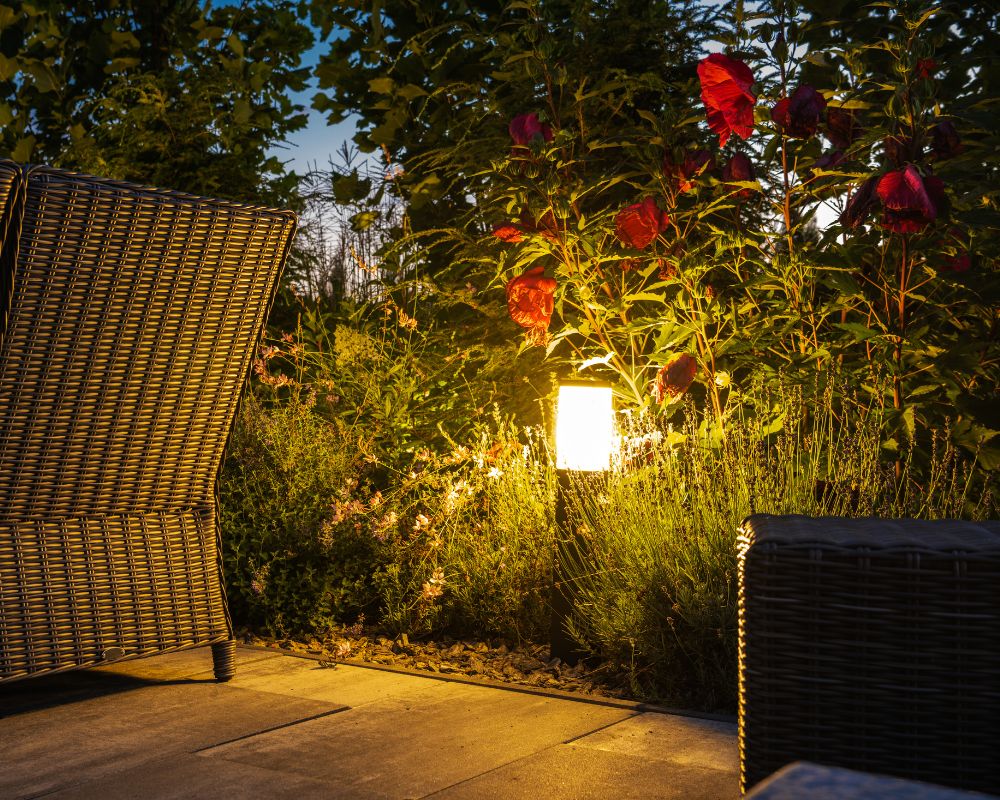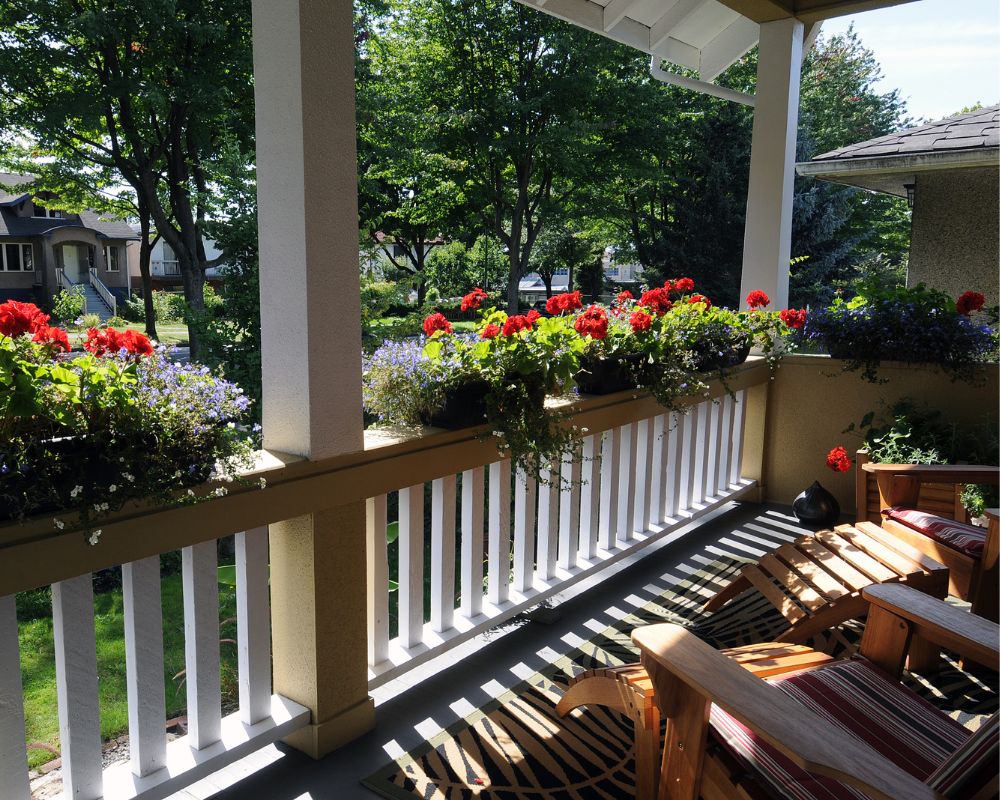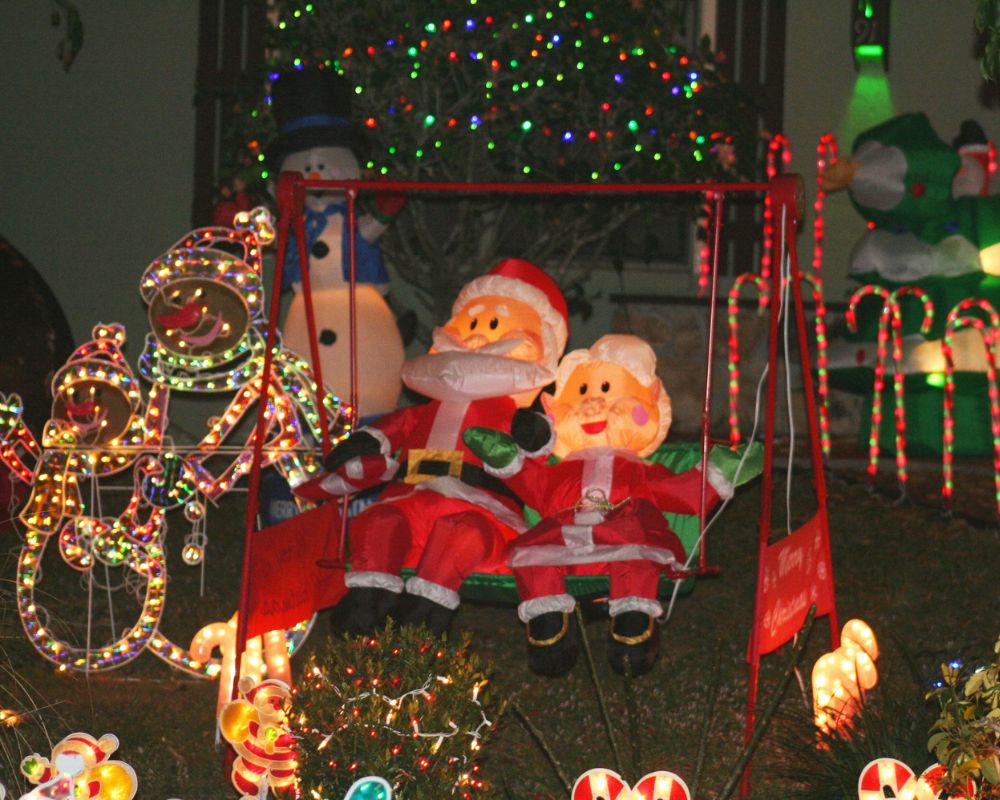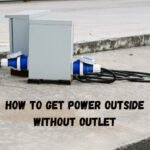Wondering on how to get power outside without outlet? Outdoor activities often require energy, whether for powering a laptop or a camping stove. However, without an outlet nearby, it may seem impossible to get power outside.
The most classic method is using renewable energy sources such as solar or wind power. Solar panels can be used to charge batteries and run small appliances like lighting systems, battery chargers and even radios.
Meanwhile, wind turbines use the flow of air to create an electric current that can feed small electrical devices as well as charge batteries for later use. Both solutions are easy to set up and relatively low cost compared to other options.
There are several ways to generate electricity and power devices when outdoors – no outlets required.
How to Get Power Outside without Outlet

If you need an outdoor power source but there is no accessible electrical outlet to plug into, then you may consider using alternative power sources such as solar panels or generators:
1. Portable Generators
Portable generators are an invaluable tool for getting power outside when a conventional outlet is not available. They provide the reliable electricity that is needed to power a range of outdoor events, such as camping trips, music festivals and construction sites. With the right portable generator, you can easily get power outside without an outlet.
The first step in getting power outside without an outlet is to choose a suitable generator. Portable generators come in all shapes and sizes, so it’s important to select one that meets your specific needs.
Consider factors like the amperage rating, wattage output and fuel type before making your decision. Gasoline-powered models tend to be more powerful than solar or battery-powered ones so they’re ideal for longer events with high energy demands.
2. Solar Panels
Solar panels are an efficient way to get power outside without an outlet. They are becoming increasingly popular due to their low startup costs and long-term savings potential.
Solar panels harness the sun’s energy, transforming it into usable electricity for powering appliances and electronics. Installing a solar panel system is not as complicated as it may seem; with some basic knowledge, anyone can have access to clean renewable energy from the sun.
With advancements in technology, installing solar panels on your property has never been easier or more affordable. Home solar panels are a great investment for those who want to reduce their carbon footprint and save money on energy bills.
Not only are they environmentally friendly, but they can also increase the value of your home. The long-term financial savings from having solar panels is an attractive feature for most homebuyers.
To get started with solar power outdoors, one must first determine how much power they will need and pick out an appropriate sized panel system.
Next, find a sunny spot in your yard or on your roof that gets at least five hours of direct sunlight each day. To make sure installation goes smoothly, read through all instructions provided in your kit before beginning the process.
3. Battery-Powered Devices
Battery-powered devices are a great way to stay connected on-the-go and keep your gadgets charged when no electrical outlets are available.
From USB battery packs for charging phones or other USB powered devices, to solar powered panels that can be used in camping or outdoor activities, there is a range of device options that allow you to get power outside without an outlet.
All of these devices are designed with convenience in mind and offer users the freedom they need when they’re on the go. Using this type of technology makes it easier than ever before to stay connected wherever you go.
4. Extension Cords
Extension cords are the ultimate convenience when it comes to powering outdoor activities without the need for an outlet.
An extension cord allows you to connect your appliances and tools to a power source that’s outside of the home, giving you access to electricity in places where outlets don’t exist or aren’t easily accessible.
Whether you need power for a holiday party or just want some extra juice for your tools while working outside, here are a few tips on how to get power outside without an outlet.
First, make sure that the extension cord is rated for outdoor use. Extension cords designed specifically for outdoor use will have thicker insulation and waterproof plugs which will prevent them from short-circuiting due to moisture and weather conditions. Next, determine the length of extension cord needed depending on where your device needs to be powered.
5. Inverters
Car power inverters are an easy and convenient way to get power outside without having to rely on an outlet.
They allow you to use the car battery for powering electronics such as phones, laptops, and other devices. Inverters convert 12-volt DC current from a vehicle’s battery into a reliable AC current that can be used in any device with an AC adapter.
This makes them ideal for camping trips, tailgating parties, or any other situation where access to conventional electricity might not be available.
With the right car power inverter, you can quickly and easily plug electronic devices into your vehicle’s cigarette lighter socket.
How can I light my porch without electricity?

Powering a porch, deck or garden with light can be a daunting challenge if there is no nearby outlet. Fortunately, there are many easy-to-install products available that use energy sources other than electricity to illuminate outdoor areas.
Solar-powered lights are one of the most popular LED lighting solutions because they are inexpensive and easy to install. They store up solar energy during the day and then turn on automatically when the sun sets. Additionally, solar path lights can be used for lighting driveways or walkways for added safety and security.
If your area does not receive direct sunlight suitable for powering solar lights, you can find battery-operated LED fixtures that can last from 20 to 200 hours on one set of batteries depending on how bright you set them. Battery operated motion sensor floodlights are also available and will only turn on when triggered by activity in the designated area — a great way to keep your potential visitors safe without sacrificing style or convenience!
In addition, there are solar charging cell phone stations with USB chargers that bring WiFi access into your outdoor space as well as automatic camping lanterns perfect for any camping or hiking adventure! With all these options now available, setting up low voltage light outdoors has never been easier!
How do you install an exterior electrical outlet?

Installing exterior outlets provides more LED lighting and decorative outdoor lighting options to suit your needs.
This can be achieved by running underground wiring without sacrificing curb appeal or your safety. Read on to learn how to install an exterior electrical outlet safely and easily.
- First, select a GFCI (ground fault circuit interrupter) outlet for a waterproof sealed box that is weather-resistant when buried in the ground. It is also important to take into consideration which type of conduit you need for the project: non-metallic or metal conduit.
- Next, carefully follow the instructions of your GFCI outlet installation guide, including those related to cable sizing, outdoor outlets placement and panel grounding requirements.
- Between the house and the location of the GFCI outlet, use feeder conductors that are designed with one hot wire and one neutral wire (no bare ground wires). When it comes to routing underground cables, respect all applicable building codes.
- Once wiring is complete, test that it works properly before burying it in its designated trench for maximum protection from water damage due to weather conditions such as rain or irrigation systems.
- Insulating materials may also be necessary for additional protection when burying cables in order to ensure power lines remain stable and intact without risk of electrocution when exposed to water in the ground.
Battery powered outlet for outdoor lights

If you are looking for a clever solution to keeping your outdoor lights going without having to worry about running power lines or hiring an electrician, battery-powered outlets may be the answer. These great little devices allow you to tap into the power of batteries to power your outdoor lights without sacrificing convenience or quality.
Battery-powered outlets come in a variety of forms and allow you to take advantage of many different types of batteries, from Solar charged lead-acid batteries and rechargeable lithium-ion batteries to alkaline and non-rechargeable dry cell batteries. Depending on the type of battery you choose, you can expect from one month up to one year of life from the outlet before needing to replace the battery. In addition to this pollution free energy source, these outlets are usually shockproof, waterproof, tamper proof and made from heavy duty materials that won’t corrode with age or wear down in harsh weather conditions.
The most attractive feature is that it also makes installation simple — just mount the outlet wherever there is light exposure, plug an appliance cord into it or screw in lamp holders directly and make sure the connection is secure before switching on your light source. If using alkaline or dry cell batteries make sure they are inserted correctly with the right polarity and check regularly for any corrosion prior to use for best results and longer lasting power availability.
DIY outdoor lighting without electricity
Outdoor lighting without electricity can be easily accomplished with a few creative and cost-effective alternatives. Whether you want to light up a garden, yard, pathway or other outdoor area, there are innovative DIY solutions to help you do it in an efficient and environment-friendly manner. Here are some of the most popular options for providing outdoor lighting without resorting to an electrical outlet:
Solar Lights
Solar powered lights make use of natural energy from the sun’s rays during the day and store them in rechargeable batteries. This energy is then used to power the lights at night when those same batteries can now be used as an energy source. Solar lights come in a variety of shapes, sizes, and styles making them easy to integrate into any type of outdoor area.
Wind Energy Lights
These types of lights do not require electricity either – they simply use the wind as their source of power. The blades on these wind-powered lights will spin at night when there is air passing over them, providing light all night long. Wind energy lights typically have a very low maintenance requirement as they are designed to function with minimal intervention from the user.
Candle Lanterns
Candle lanterns are an old fashioned solution but still offer modern style and efficiency in outdoor lighting today due to advances in materials and quality construction techniques. Your candles should be placed inside glass cylinders in order for optimum light output with minimum wind loss or fire hazard concerns.
Motion Activated Lights
Motion activated lights are perfect for adding security around your home or special decorations near your entranceway or around pathways . They work by sensing motion within a certain range and then illuminating the area when triggered by people passing through that space . This is ideal for providing temporary light where it might not always be needed . As motion no longer triggers them ,they will switch off after about 15 minutes thus helping conserve energy usage
Christmas Lights Without Electricity

Christmas lights without electricity are a fun and easy way to brighten up your outdoor area without the need for an electrical outlet. While it will take some creativity and know-how, creating your own power source and using solar-powered, battery-powered, or manual Christmas lights is a great way to decorate your yard outdoors while using renewable resources. Here are some tips and ideas to get you started:
- Solar Christmas Lights: Solar-powered Christmas lights are ideal for outdoor holiday displays as they can absorb sunlight during the day and turn on automatically at night in most cases. They’re also generally more energy efficient than electric powered string lights.
- Battery Operated Christmas Lights: Battery operated string lights are good for brighter colors but have less battery life than solar powered ones. However, they can be easier to set up as you don’t have any wiring concerns to worry about, so if you plan on moving the display each year or don’t want any kind of electrical connection, this is a great option.
- Manual Powered Christmas Lights: Manual powered string lights are operated by a small crank on the base of the light that winds up like a toy, and typically offer different settings like twinkle or fading effects when used with LED lights. These lights tend to be much less expensive than either solar or battery operated ones but may have shorter bulb life spans due to the strain of being wound up each time they’re used.
Customize your Outdoor Neon Lights

Does your event venue need colorful lighting? Are you worried about how to throw a party that will impress you? The Custom Outdoor Neon Signs are easy to install, lightweight and suitable for a variety of outdoor occasions, comes with a free remote control and dimmer, and comes with a battery pack option for small signs that can be carried around in carts and stalls. Customized neon lights have fine workmanship, no noise, no heat, energy saving and environmental protection, and are the best choice for outdoor decoration.
How much does it cost to put in an outside outlet?
The cost of having an outside outlet installed will depend on the job itself and the type of outlet you want installed. In most cases, the installation will involve hiring a qualified electrician which can range from about $300-$500 depending on the complexity of the job.
However, if you have some basic electrical knowledge and tools, it may be possible to install one yourself for around $50-$75. The total cost will also include any materials such as wire, outlets, junction boxes or conduit that are needed for the installation.
Are Outdoor Lights Safe in the Rain?
Yes, with the proper installation and maintenance, outdoor lights can be kept in good working condition even in wet weather.
It is important to make sure that all outdoor lighting fixtures have been properly installed according to their manufacturer specifications. This ensures that the fixture is able to withstand moisture and will not become damaged or corroded when exposed to rainwater.
Additionally, it is important to ensure that all electrical wiring running between fixtures is shielded from water damage with waterproof coverings or conduit connections where necessary.
To ensure your outdoor lights stay safe during wet weather it’s also important you carry out regular maintenance on them like regularly cleaning the fittings and changing any burnt-out bulbs as soon as possible.
Do outdoor lights need to be on their own circuit?
Installing outdoor lights on their own dedicated circuit is essential in order to prevent any overloads on the main electrical wiring system. By having them on a separate line, it will help keep your other household appliances safe from overloading circuits and cause fewer issues with flickering or dimming lights. This also ensures a consistent level of energy going into each light fixture, which can help improve performance and longevity. It’s always best practice to hire an electrician for such installations, as they will make sure all safety precautions are taken care of during installation.







